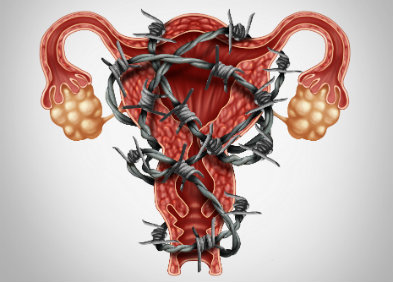WHAT IS ENDOMETRIOSIS?
Did you know that endometriosis is an incurable but manageable gynecological disease?
It is the presence of a uterine lining (endometrium) outside the uterine cavity that is its normal location: on the cervix, fallopian tubes, ligaments, ovaries, peritoneum, vagina, vulva, etc ... Sometimes, this mucous membrane is observed on the non-genital organs: bladder, cecum, appendix, colon, sigmoid.
Fortunately, Dawasanté experts have put natural treatment within your reach to cure endometriosis without surgery.

Click here to discover our natural treatment or Contact our experts, tel / WhatsApp: +33644661758 / +22990312738
Endometriosis: causes and risk factors

In addition to this, you need to know more about it.
This condition affects women aged 25 to 45 with no or few children but often a gynecological operative history, early periods (before 11 years), long, painful, with cycles of less than 27 days, exposure in utero with diethylstilbestrol. The prevalence is estimated between 6 and 10% in the general female population, this figure reaches 35 to 50% in women with pelvic pain and infertility. Then women with swollen bellies.
The major cause is however unknown, this disease still raises many questions.
Signs of endometriosis

Women suffering from this pathology usually complain of the following:
at. Heavy and painful periods, especially around the 3rd or 4th day of the cycle. It is the most evocative and frequent symptom. Sometimes the pain is less typical in its date, duration, appearance in relation to menstruation, location (pelvic, abdominal, lumbar, sacral), but the existence of pain is almost constant.
b. Sometimes the pain is found during intercourse;
vs. swollen belly.
d. Infertility is frequently associated.
Endometriosis: which tests to diagnose the disease?

Several examinations allow the diagnosis to be made:
- A pelvic or endovaginal ultrasound will help locate endometriotic cysts outside the uterus;
- Hysterosalpingography (x-ray of the uterus and tubes after injection of a contrast product) can possibly be used to look for indirect signs of adenomyosis (a form of endometriosis where endometrial cells have migrated inside the uterine muscle. even) or assesses problems with the patency of the uterine tubes (which may be blocked);
- Any radiological examination in locations where lesions are suspected, such as in the urinary tract (urography);
- Magnetic resonance imaging (MRI) is very reliable and even more precise than ultrasound.
Ultrasound and laparoscopy allow biopsies to confirm the diagnosis.
Treatment of endometriosis

In the event of painful symptoms, medical treatment is often sufficient. It is based on
- taking synthetic progestins, which, by blocking ovulation and menstruation, put endometriosis foci at rest for 6 to 18 months.
- Danazol-type antigonadotrophins appear to be effective.
- LH-RH analogs are also used to rest the ovaries in women with endometriosis.
- More recently, aromatase inhibitors are used.
Endometriosis implants can be surgically removed or destroyed by electrocoagulation or laser if necessary.
After menopause, the pain usually goes away spontaneously. If persistence, a hysterectomy may be performed.
Living with endometriosis
Endometriosis has a strong impact on family life and on couples, and it is also manifested by swelling of the belly. Painful episodes are difficult for patients to experience. Psychological support can help women better understand their pain. Likewise, alternative medicine such as acupuncture or osteopathy can help patients relieve their ailments. It is essential to take care of yourself, to find relaxation methods that allow you to live better with the disease. Women suffering from endometriosis can also find an attentive ear with the regional representatives of the EndoFrance association who support and advise them.
endometriosis remains a taboo disease. Yet it affects millions of women of reproductive age. It is characterized by the presence of the endometrium, normally located inside the uterus, outside the uterine cavity. According to EndoFrance, the French association for the fight against endometriosis, the diagnosis often comes seven years after the first symptoms.
Abnormal pain during menstruation
“The real sign is the severe pain you get during your period. If you have so much pain that you have to lie down at home, feel unwell or miss your work or school, there is a good chance that it is endometriosis ”, announces Erick Petit. , specialist radiologist, and founder of the Endometriosis Center of the Paris Saint-Joseph Hospital Group (Paris XIVe).
According to this specialist, menstrual pain should never be trivialized. If they are not relieved by taking paracetamol or they are disabling since the first menstruation, it is imperative to consult. “During a first interview, we ask the intensity of the pain from our patients, if they assess it beyond 6 on a scale of 10, it is endometriosis,” says the radiologist.
Painful intercourse

"After each orgasm, I felt like a cramp all over my uterus, similar to a stab, it forced me to twist myself for ten minutes", testified a young woman of 29 years in a previous article published in March 2016 on daily living with endometriosis. “If the patient feels pain in the lower abdomen during intercourse or just after, this is a very reliable sign of endometriosis,” underlines Erick Petit.
Called “deep dyspareunia”, this pain is sometimes underestimated because it is considered normal during penetration when it is not. In endometriosis, this pain may also be more acute during ovulation or menstruation.
Infertility or difficulty in procreating
Endometriosis is the number one cause of infertility in women. It is often when couples consult for reproductive difficulties that the diagnosis of the disease is established. "If despite three weekly sexual intercourse, we cannot procreate after a year, we must look at the endometrium," says Erick Petit.
There are also other manifestations of this pathology, such as pain felt while urinating, such as when suffering from cystitis, difficulty urinating, or defecating. “All these symptoms are not necessarily combined. This disease is polymorphic, that is to say, that each patient is different and the disease can evolve, ”emphasizes the professional.
Who to consult?
So what should you do when you have these symptoms? Erick Petit advises consulting a gynecologist or a radiologist specializing in endometriosis. "It is imperative to do an endovaginal ultrasound (medical imaging technique which consists of exploring the uterus and the ovaries using a probe, editor's note) to detect the disease, but the professional must be trained for it. detect on the images, ”he recalls.
Unfortunately, there are still a few specialized centers in France. "2 million women are affected, but the number of trained doctors is insufficient," laments the specialist. The Resendo association provides a list of health professionals in France for better care of women with the disease. The list is not very long and waiting times are rather two to four months in the city, against a year in some centers specializing in hospitals.
What are the symptoms of endometriosis?
They can be multiple and related to the location of the disease, chronic or periodic, or completely absent in asymptomatic forms, and their intensity is not indicative of the severity of the lesions.
Pain: the main symptom
The most common symptom of endometriosis (found in 50 to 91% of women according to studies) is pain, painful periods (dysmenorrhea), pain during intercourse (dyspareunia), frequent pelvic pain, painful defecation, difficulty in urinating (dysuria), lower back pain, abdominal pain (umbilicals, etc.), pelvic or lower back pain which may radiate into the leg (cruralgia), etc.
This pain is not primary dysmenorrhea which passes with paracetamol. It is very often a disabling pain resulting in total or partial incapacity for a few days, or even, in the most severe cases, permanent, and requiring the use of powerful analgesics and even morphine.
Gynecological pain is THE most obvious symptom of endometriosis.
It, therefore, seems incomprehensible that patients suffering from disabling pelvic pain since their first period are diagnosed after six years on average.
Pain associated with endometriosis can be continuous or occasional, depending on the location of the lesions and adhesions. Linked to the cycle, it often manifests itself more acutely during ovulation or menstruation.
For some, it will be the inability to lead a normal, professional, family, and intimate life, whether for a few days or permanently. For others, it will be the inability to exert any physical effort, whether it's lifting their grocery bag or just standing up.
For still others, it will be so painful that it will cause blackouts and vomiting. For these, it will be impossible to stay long in the same position, and changing it will be just as painful as keeping it. For these, it will be necessary to resort to pain-relieving drugs, such as opioids, which will give them respite, when they are not used to it, in exchange for formidable side effects.
For all, the worst prison, the one where the mind is nothing but pain in a painful body. The one where we hope and fear the coming moment. Where we are ready to try everything, from the miracle cure to the guru, to escape the pain.
Click here to discover our natural treatment or Contact our experts, tel / WhatsApp: +33644661758 / +22990312738